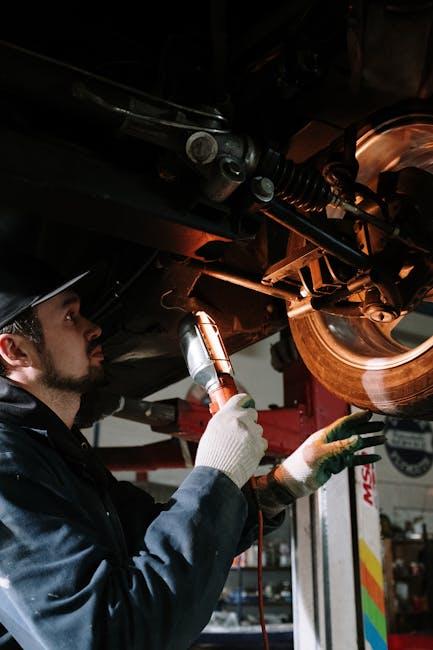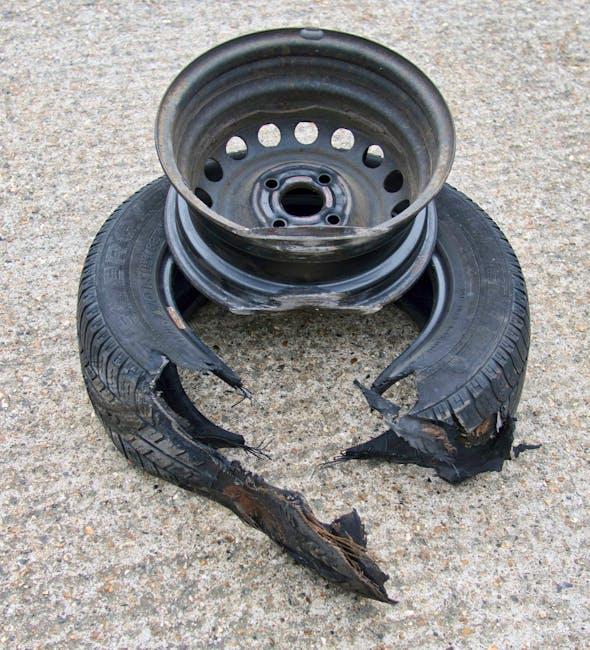Imagine cruising down the road when suddenly, your car’s radio goes silent or the headlights flicker out unexpectedly. In many cases, the culprit behind these frustrating hiccups is a blown fuse—an often overlooked but vital component in your vehicle’s electrical system. While it may sound intimidating, fixing a blown car fuse is a straightforward task that can save you time, money, and a trip to the mechanic. In this article, we’ll guide you through the essential steps to identify, replace, and prevent blown fuses, empowering you to keep your car’s electrical heartbeat running smoothly.
Table of Contents
- Understanding the Role of Car Fuses in Vehicle Electrical Systems
- Identifying Symptoms and Common Causes of Blown Fuses
- Essential Tools and Safety Precautions Before You Begin
- Step-by-Step Guide to Locating and Inspecting Car Fuses
- Choosing the Right Replacement Fuse for Your Vehicle
- Tips for Preventing Future Fuse Blowouts and Electrical Issues
- Q&A
- In Summary

Understanding the Role of Car Fuses in Vehicle Electrical Systems
Car fuses serve as the unsung guardians of your vehicle’s electrical system. Embedded within a web of circuits, these tiny components act as crucial safety valves, designed to prevent catastrophic damage by interrupting electrical flow when a surge or short circuit is detected. Without them, sensitive electrical components—like your radio, headlights, or onboard computer—would be vulnerable to irreparable harm. Think of fuses as vigilant gatekeepers that sacrifice themselves to protect an otherwise complex and delicate network of wires and devices.
Identifying and understanding how fuses operate is essential when troubleshooting vehicle issues. They come in various types and ratings, each tailored to specific circuits. Being informed of the differences can aid you in quickly locating the problem and replacing a blown fuse with the right one. Here’s a quick glance at common fuse types and their typical uses:
| Fuse Type | Amperage Range | Common Applications |
|---|---|---|
| Blade Fuse | 5A–30A | Lights, Audio Systems |
| Glass Tube Fuse | 3A–40A | Older Models, Accessories |
| Mini Fuse | 2A–30A | Modern Electronics, Control Modules |
When inspecting your car’s electrical issues, keep these points in mind:
- Location: Fuse boxes can be found under the hood or inside the cabin, each controlling different circuits.
- Rating: Always replace a blown fuse with one of the exact amperage rating to avoid further damage.
- Signs of Damage: A broken filament or discoloration inside the fuse typically indicates it’s blown.
- Prevention: Regular checks can catch fuse problems before they lead to bigger electrical failures.

Identifying Symptoms and Common Causes of Blown Fuses
When your vehicle suddenly loses power to electrical components such as the radio, headlights, or power windows, it’s often a sign that a fuse has blown. You might notice flickering lights or gadgets that stop working altogether, which serves as a strong indicator that the fuse protecting that circuit has failed. A visual inspection of the fuse often reveals a broken filament or discoloration inside the transparent casing, giving you the first clue to the trouble. However, some symptoms can be subtler, like inconsistent functionality or intermittent electrical issues that complicate diagnosis without proper testing tools.
Understanding why fuses blow is crucial to prevent recurrence. The most common culprits include short circuits caused by damaged wiring, overloaded circuits when accessories draw more current than the fuse rating allows, or environmental factors such as moisture and corrosion. Below is a quick reference table to help identify typical causes by fuse type:
| Fuse Location | Common Cause | Symptoms |
|---|---|---|
| Engine Compartment | Wiring damage due to heat or vibration | Engine won’t start, dashboard issues |
| Interior Fuse Box | Accessory overload (e.g., aftermarket electronics) | Power windows or radio fail intermittently |
| Fuse Links | Severe short circuit from damaged wiring | Complete loss of power to major systems |
By pinpointing these symptoms early and understanding their root causes, you prevent chain reactions that could lead to more costly electrical problems in your car.

Essential Tools and Safety Precautions Before You Begin
Before diving into the repair process, having the right tools and following safety measures can save you time and prevent unwanted mishaps. Essential tools include a multimeter to check for electrical continuity, a fuse puller for safely removing blown fuses, and a set of replacement fuses that match your vehicle’s specifications. It’s also wise to have a flashlight handy for better visibility inside the fuse box, especially in low light conditions. Keeping these items organized in a small tool kit within your car ensures you’re never caught unprepared on the road.
Safety should always be your top priority when handling your car’s electrical system. Start by turning off the engine and removing the key from the ignition to avoid any accidental sparks. Make sure your hands are dry and avoid working in wet conditions to reduce the risk of electric shock. Additionally, wearing insulated gloves adds an extra layer of protection. Refer to your vehicle’s manual to locate the fuse panel and identify the exact fuse related to the malfunctioning component—this prevents unnecessary fumble and potential damage.

Step-by-Step Guide to Locating and Inspecting Car Fuses
First, grab your vehicle’s owner manual—it’s your treasure map to uncovering the fuse box locations. Most cars have more than one fuse box; commonly, you’ll find one nestled under the dashboard, often on the driver’s side, and another tucked away in the engine compartment. Once located, slide off the panel cover gently; underneath, you’ll discover a precise diagram detailing each fuse’s function and rating. This is your key to identifying the fuse that corresponds to the faulty component, such as headlights or the radio.
Next comes the inspection phase, where a keen eye will pay dividends. Using a fuse puller (or a pair of needle-nose pliers), carefully extract the suspect fuse. Hold it up to a light and examine the thin wire inside—if it’s broken or charred, that’s your blown fuse culprit. For added thoroughness, a multimeter can be employed to test continuity, ensuring the fuse’s health beyond visual cues. Remember to replace blown fuses with new ones of the same amperage rating to avoid electrical mishaps.
- Locate fuse box using vehicle manual
- Refer to fuse diagram on the panel cover
- Use a fuse puller to safely remove the fuse
- Inspect the fuse wire for breaks or burn marks
- Test with a multimeter if available
- Replace with identical amperage fuse

Choosing the Right Replacement Fuse for Your Vehicle
When selecting a replacement fuse for your vehicle, it’s crucial to match the amperage rating exactly to the original fuse. Using a fuse with a higher amperage can bypass the safety mechanism, putting your electrical system at risk of damage or even fire. Conversely, a lower-rated fuse will blow prematurely, causing recurrent issues. Always check the fuse box cover, owner’s manual, or the fuse itself for clear markings that indicate the required rating.
Besides amperage, consider the type and size of the fuse to ensure compatibility. Automotive fuses come in various forms such as blade fuses, glass tube fuses, and maxi fuses, each designed for specific applications. Here’s a quick reference guide to common fuse types:
| Fuse Type | Common Usage | Shape & Size |
|---|---|---|
| Blade Fuse | Most modern vehicles | Flat, plastic body with two metal prongs |
| Glass Tube Fuse | Older model cars and motorcycles | Cylindrical glass tube with metal end caps |
| Maxi Fuse | High-current circuits such as alternators | Large, robust blade-style |
Keeping these factors in mind will make sure your replacement fuse performs its protective role effectively without causing unnecessary interruptions or hazards.

Tips for Preventing Future Fuse Blowouts and Electrical Issues
Staying proactive about your vehicle’s electrical health can save you from frequent headaches and unexpected fuse blowouts. Start by regularly inspecting fuse connections and ensuring they stay clean and free from corrosion, which often causes resistance and heat buildup. Avoid overloading circuits by not adding unauthorized electrical accessories or devices that draw more power than your vehicle’s system can supply. Always use fuses with the correct amperage rating for replacement—mismatched fuses are a common culprit behind repeated failures.
Implementing simple habits can dramatically reduce the risk of electrical faults down the road. Consider the following:
- Keep wiring harnesses secured: Loose wires can rub against sharp edges, leading to shorts.
- Use dielectric grease: Apply it to fuse terminals to prevent moisture damage.
- Perform regular electrical system checks: Services at scheduled intervals often catch small issues before they escalate.
To illustrate maintenance frequency, here’s a quick guide for checking electrical components:
| Component | Check Interval | Maintenance Tip |
|---|---|---|
| Fuses | Every 6 months | Inspect & clean terminals |
| Wiring Harness | Annually | Secure & check for wear |
| Fuse Box | Every oil change | Check for corrosion/moisture |
Q&A
Q: What exactly is a blown car fuse?
A: A blown car fuse is like a tiny safety guardian inside your vehicle’s electrical system. When something electrical goes wrong—like a short circuit or an overload—the fuse sacrifices itself by “blowing” to stop the flow of electricity and protect more expensive parts from damage.
Q: How can I tell if a car fuse is blown?
A: You can spot a blown fuse by peering through its translucent casing. If the metal wire inside looks broken or burnt, that’s your telltale sign. Some cars also show warning lights on the dashboard when a fuse has blown.
Q: Where are the fuses located in a car?
A: Most cars house their fuses in one or more fuse boxes, typically found under the dashboard, inside the engine compartment, or near the glove box. Your owner’s manual will be your treasure map to these little boxes.
Q: What tools do I need to fix a blown fuse?
A: You’ll need a fuse puller or needle-nose pliers, replacement fuses of the correct amperage (never use a fuse with a higher rating), and possibly a flashlight or your phone’s light to see clearly.
Q: How do I fix a blown fuse step-by-step?
A:
- Turn off your vehicle and remove the key.
- Locate the fuse box and open it using the guide in your manual.
- Identify the fuse that’s blown—look for a broken filament inside.
- Use the fuse puller or pliers to carefully remove the faulty fuse.
- Insert a new fuse with the exact same amperage rating.
- Close the fuse box and start your car to check if the issue is resolved.
Q: Can I reuse a blown fuse?
A: Nope! Once a fuse has done its job and blown, it can’t be reused. Always replace it with a brand-new one to keep your car’s electrical system safe.
Q: Why do car fuses blow repeatedly?
A: A fuse blowing over and over is a red flag signaling a deeper issue—like a short circuit, faulty wiring, or a malfunctioning electrical component. If this happens, professional diagnostics might be your best friend.
Q: Is it safe to replace a fuse myself?
A: Yes! Replacing a fuse is a straightforward and safe task as long as you follow the instructions, use the correct fuse type, and ensure your vehicle is turned off during the process.
Q: Are all car fuses the same size?
A: Nope, fuses come in various sizes and shapes—mini, micro, standard blade types, and more. Using the right size is crucial for a proper fit and function.
Q: What if replacing the fuse doesn’t fix the problem?
A: If the new fuse blows right away or the electrical component still doesn’t work, it could mean there’s an underlying electrical fault. At this point, a visit to a qualified mechanic or auto electrician is recommended to prevent further damage.
Q: Can I carry spare fuses in my car?
A: Absolutely! Keeping a small kit of commonly used spare fuses in your glove box can save you time and stress when an unexpected fuse failure occurs on the road.
This Q&A serves as your quick guide to understanding and fixing blown car fuses, empowering you to keep your vehicle’s electrical system humming smoothly.
In Summary
In the end, tackling a blown car fuse isn’t just about replacing a small piece of metal; it’s about restoring the flow of power that keeps your vehicle’s vital functions humming smoothly. With a little patience, the right tools, and a careful eye, you can bring your car’s electrical system back to life and avoid those unexpected roadside frustrations. So next time a fuse blows, don’t see it as a dead end—consider it a small puzzle waiting for your steady hands and sharp mind to solve. Safe driving and happy fixing!


2 Comments
h7h3s2
h7h3s2